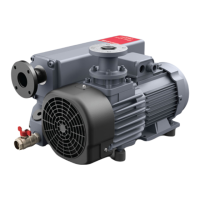5. A warning sign bearing a legend such as "Work in progress; do not start" shall be
aached to the starng equipment.
6. Persons switching on remotely controlled machines shall take adequate
precauons to ensure that there is no one checking or working on the machine. To
this end, a suitable noce shall be axed to the remote start equipment.
7. Before removing any component, eecvely isolate the machine from all sources
of under and/or overpressure and make sure that the pump system is at
atmospheric pressure level.
8.
Never use ammable solvents or carbon tetrachloride for cleaning parts. Take
safety precauons against toxic vapours of cleaning liquids.
9.
Scrupulously observe cleanliness during maintenance and repair. Keep dirt away by
covering the parts and exposed openings with a clean cloth, paper or tape.
10.
Never weld or perform any operaon involving heat near the oil system. Oil tanks
must be completely purged, for example, by steam cleaning, before carrying out
such operaons. Never weld on, or in any way modify, pressure vessels.
11.
Whenever there is an indicaon or any suspicion that an internal part of a machine
is overheated, the machine shall be stopped but no inspecon covers shall be
opened before sucient cooling me has elapsed. This will avoid the risk of
spontaneous ignion of the oil vapour when air is admied.
12.
Never use a light source with an open ame for inspecng the interior of a
machine, pressure vessel, and so forth.
13. Make sure that no tools, loose parts or rags are le in or on the machine.
14. All regulang and safety devices shall be maintained with due care to ensure that
they funcon properly. They may not be put out of acon.
15.
Before clearing the machine for use aer maintenance or overhaul, check that
operang pressures, temperatures and me sengs are correct. Check that all
control and shut-down devices are ed and that they funcon correctly. If
removed, check that the coupling guard of the vacuum pump drive sha has been
reinstalled.
16. Every me the separator element is renewed, examine the discharge and the
inside of the oil separator vessel for carbon deposits. If there are excessive
deposits, remove it.
17.
Protect the motor, air lter, electrical and regulang components, and so forth, to
prevent moisture from entering them, for example, when steam cleaning.
18.
Make sure that all sound damping material and vibraon dampers, for example,
damping material on the bodywork and in the air inlet and outlet systems of the
vacuum pump are in good condion. If damaged, replace it with genuine material
from the manufacturer to prevent the sound pressure level from increasing.
19.
Never use causc solvents which can damage materials of the air net, for example,
polycarbonate bowls.
20.
Faults or wearing of seals may cause oil lubricant leaks. Avoid dispersion in soil and
polluon of other materials.
Note:
Refer to Safety precauons during installaon on page 10 Safety precauons
during installaon on page 8 and Safety precauons during operaon on page 12
Safety precauons during operaon on page 9.
07/2020 - Page 11
A35104880_B - Safety and compliance

